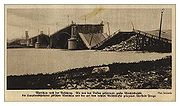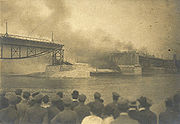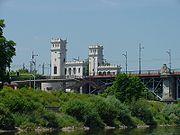
Poniatowski Bridge
Encyclopedia

Bridge
A bridge is a structure built to span physical obstacles such as a body of water, valley, or road, for the purpose of providing passage over the obstacle...
in Warsaw
Warsaw
Warsaw is the capital and largest city of Poland. It is located on the Vistula River, roughly from the Baltic Sea and from the Carpathian Mountains. Its population in 2010 was estimated at 1,716,855 residents with a greater metropolitan area of 2,631,902 residents, making Warsaw the 10th most...
. Originally built between 1904 and 1914, it was damaged in each of the World Wars and rebuilt afterwards. It spans the Vistula
Vistula
The Vistula is the longest and the most important river in Poland, at 1,047 km in length. The watershed area of the Vistula is , of which lies within Poland ....
, connecting Powiśle
Powisle
Powiśle is a neighbourhood in Warsaw's borough of Śródmieście . It is located between the Vistula river and its escarpment...
with the Praga
Praga
Praga is a historical borough of Warsaw, the capital of Poland. It is located on the east bank of the river Vistula. First mentioned in 1432, until 1791 it formed a separate town with its own city charter.- History :...
quarter on the other side. Its viaduct
Viaduct
A viaduct is a bridge composed of several small spans. The term viaduct is derived from the Latin via for road and ducere to lead something. However, the Ancient Romans did not use that term per se; it is a modern derivation from an analogy with aqueduct. Like the Roman aqueducts, many early...
is an extension of Aleje Jerozolimskie
Aleje Jerozolimskie
Aleje Jerozolimskie is one of the principal streets of the city of Warsaw in Poland. It runs through the City Centre along the East-West axis, linking the western borough of Wola with the bridge on the Vistula River and the borough of Praga on the other side of the river.The name of the street...
.
The 506 m long steel bridge, consisting of eight span
Span (architecture)
Span is the distance between two intermediate supports for a structure, e.g. a beam or a bridge.A span can be closed by a solid beam or of a rope...
s, was designed by Stefan Szyller. Its construction, started in 1904, was supervised by engineers Mieczysław Marszewski and Wacław Paszkowski. Despite being viewed by many as an extravagance (opponents of its construction included the then mayor of Warsaw and the writer Bolesław Prus), it was opened on January 6, 1914, by the Russian Governor General, Georgi Skalon
Georgi Skalon
Georgi Skalon was a Russian Empire Governor-general of Warsaw and the chief commander of Warsaw Military District from 1905-1914....
, as Warsaw's third bridge; hence it was nicknamed "third bridge" (Polish
Polish language
Polish is a language of the Lechitic subgroup of West Slavic languages, used throughout Poland and by Polish minorities in other countries...
: "trzeci most") by the city's residents, though its official name was "Bridge of Our Most Gracious Ruler, Tsar
Tsar
Tsar is a title used to designate certain European Slavic monarchs or supreme rulers. As a system of government in the Tsardom of Russia and Russian Empire, it is known as Tsarist autocracy, or Tsarism...
Nicholas II" (Warsaw then being part of the Russian Empire
Russian Empire
The Russian Empire was a state that existed from 1721 until the Russian Revolution of 1917. It was the successor to the Tsardom of Russia and the predecessor of the Soviet Union...
, following the 18th-century partitions of Poland
Partitions of Poland
The Partitions of Poland or Partitions of the Polish–Lithuanian Commonwealth took place in the second half of the 18th century and ended the existence of the Polish–Lithuanian Commonwealth, resulting in the elimination of sovereign Poland for 123 years...
). After Poland
Poland
Poland , officially the Republic of Poland , is a country in Central Europe bordered by Germany to the west; the Czech Republic and Slovakia to the south; Ukraine, Belarus and Lithuania to the east; and the Baltic Sea and Kaliningrad Oblast, a Russian exclave, to the north...
regained independence in 1918, the bridge was renamed after Prince Józef Poniatowski and acquired a new nickname — "Poniatoszczak" — which it retains to this day.


World war
A world war is a war affecting the majority of the world's most powerful and populous nations. World wars span multiple countries on multiple continents, with battles fought in multiple theaters....
s. During the First World War, in 1915, the retreating Russian army blew up four of the spans, to slow down German pursuit. The bridge was hastily rebuilt by the Germans — only to burn down in an accident soon afterwards. After the war, the structure was rebuilt by the new Polish government over the course of five years, from 1921 to 1926. During the May Coup the bridge was the meeting place of the President of Poland, Stanisław Wojciechowski, and the leader of the coup, Marshal of Poland
Marshal of Poland
Marshal of Poland is the highest rank in the Polish Army. It has been granted to only six officers. At present, this rank is equivalent to a Field Marshal or General of the Army in other NATO armies.-History:...
Józef Piłsudski. During the Second World War
World War II
World War II, or the Second World War , was a global conflict lasting from 1939 to 1945, involving most of the world's nations—including all of the great powers—eventually forming two opposing military alliances: the Allies and the Axis...
the bridge was destroyed by German troops
Nazi Germany
Nazi Germany , also known as the Third Reich , but officially called German Reich from 1933 to 1943 and Greater German Reich from 26 June 1943 onward, is the name commonly used to refer to the state of Germany from 1933 to 1945, when it was a totalitarian dictatorship ruled by...
during the Warsaw Uprising
Warsaw Uprising
The Warsaw Uprising was a major World War II operation by the Polish resistance Home Army , to liberate Warsaw from Nazi Germany. The rebellion was timed to coincide with the Soviet Union's Red Army approaching the eastern suburbs of the city and the retreat of German forces...
, on 13 September 1944. That demolition was much more complete: all spans were toppled, and only the lower pier
Pier
A pier is a raised structure, including bridge and building supports and walkways, over water, typically supported by widely spread piles or pillars...
s survived.
The first plans by the new Polish government provided for the construction of a wooden temporary structure on the surviving pillars, but hasty work caused the bridge to collapse. Restored again on new pillars, the bridge was reopened again on 22 July 1946 by Bolesław Bierut. However, the reopened bridge lost much of its pre-war splendor, as limited funds meant that there were no resources to restore various non-functional neo-Polish renaissance decorations like hand-made balustrades or stone benches. Some of the old pre-war benches, as well as one of the old spans, can be seen in the water near the bridge at low water levels.

Tram
A tram is a passenger rail vehicle which runs on tracks along public urban streets and also sometimes on separate rights of way. It may also run between cities and/or towns , and/or partially grade separated even in the cities...
track was separated from the carriageway and the bridge was connected to the Wisłostrada expressway on the left bank of the Vistula
Vistula
The Vistula is the longest and the most important river in Poland, at 1,047 km in length. The watershed area of the Vistula is , of which lies within Poland ....
by means of a long looping sloped roadway section which reminded some contemporary commentators of a snail's shell. During another repair and expansion in 1985-1990, when the roads on the right bank (Praga) were expanded, a temporary bridge (Syrena Bridge) was erected (it was in use until replaced by Świętokrzyski Bridge in 2000).
In 2004 a reconstruction and beautification of the bridge began. By 2005 the small towers and the first four spans were rebuilt. The tram track repairs were carried out in 2007.
External links
- Satellite view from Google Map

